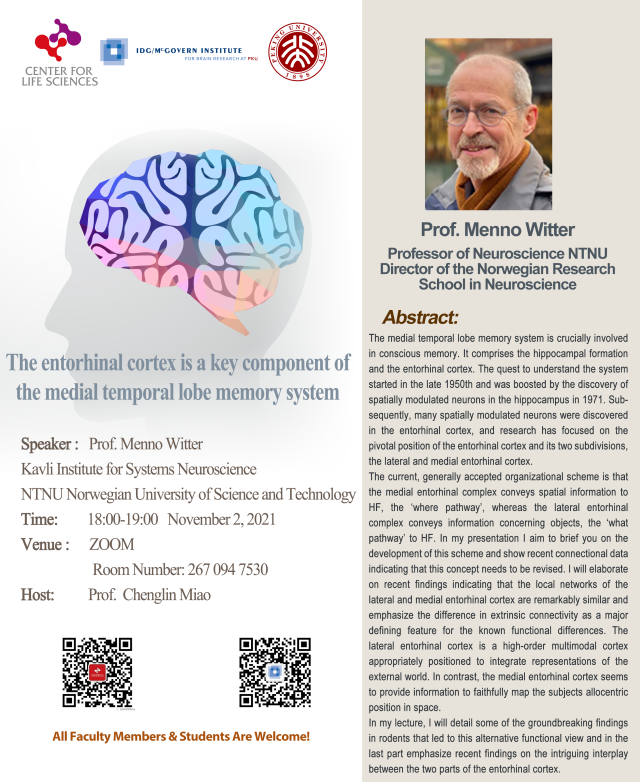Topic: The entorhinal cortex is a key component of the medial temporal lobe memory system
Speaker:Menno Witter, Kavli Institute for Systems Neuroscience, NTNU Norwegian University of Science and Technology, Trondheim, Norway
Time:Tuesday 2 November 11-12 EU time (18:00-19:00 Beijing time)
Venue:online (ZOOM)
Host:Prof. Chenglin Miao
Abstract:
The medial temporal lobe memory system is crucially involved in conscious memory. It comprises the hippocampal formation and the entorhinal cortex. The quest to understand the system started in the late 1950th and was boosted by the discovery of spatially modulated neurons in the hippocampus in 1971. Subsequently, many spatially modulated neurons were discovered in the entorhinal cortex, and research has focused on the pivotal position of the entorhinal cortex and its two subdivisions, the lateral and medial entorhinal cortex.
The current, generally accepted organizational scheme is that the medial entorhinal complex conveys spatial information to HF, the ‘where pathway’, whereas the lateral entorhinal complex conveys information concerning objects, the ‘what pathway’ to HF. In my presentation I aim to brief you on the development of this scheme and show recent connectional data indicating that this concept needs to be revised. I will elaborate on recent findings indicating that the local networks of the lateral and medial entorhinal cortex are remarkably similar and emphasize the difference in extrinsic connectivity as a major defining feature for the known functional differences. The lateral entorhinal cortex is a high-order multimodal cortex appropriately positioned to integrate representations of the external world. In contrast, the medial entorhinal cortex seems to provide information to faithfully map the subjects allocentric position in space.
In my lecture, I will detail some of the groundbreaking findings in rodents that led to this alternative functional view and in the last part emphasize recent findings on the intriguing interplay between the two parts of the entorhinal cortex.
Brief self-introduction/Biography:
Menno P. Witter is professor of Neuroscience at the Kavli Institute for Systems Neuroscience and Centre for Neural Computation at the Norwegian University of Science and Technology (NTNU) in Trondheim, Norway. He received his Ph.D. in 1985 at the VU University in Amsterdam, The Netherlands, where he subsequently started his independent research on the anatomical organization of the hippocampal region. He became full professor in 1996 and served as director of The Institute for Clinical Neuroscience at the VU University Medical School in Amsterdam (1996-2006). He further served as director of the of the Graduate School of Neurosciences Amsterdam (1996-2006). He joined professors May-Britt and Edvard Moser at the Kavli Institute for Systems Neuroscience in 2007, continuing a productive collaborative period that started in 2000, leading to the discovery of grid cells in the entorhinal cortex in 2005 for which the Mosers were awarded the Nobel prize in Physiology and Medicine in 2014. He is the initiator and current director of the Norwegian Research School in Neuroscience since 2013. He is elected member of the Royal Norwegian Society of Sciences and Letters, and The Norwegian Academy of Science, member of the European Dana Alliance for the Brain and received the Olav Thon Foundation International Research Award (2016).
He holds a visiting position at the Graduate School of Life Sciences and Faculty of Medicine, Tohoku University, Sendai, Japan. He is member of the Advisory Board Center for Behavioral Brain Sciences – CBBS Otto-von-Guericke-Universität Magdeburg, and Chair of Marseille Neuroschool Scientific, Educational and Economic Advisory Board. He is also President of the board of the FENS Trust Foundation, The Netherlands.
His current research focusses on the structural neurobiology of the lateral and medial entorhinal cortex and their contributions to learning and memory. His group also works on the mechanisms of Alzheimer’s disease, using animal models. He published over 200 papers in international peer reviewed journals. For more information and full publication list, go to http://www.ntnu.edu/employees/witter
